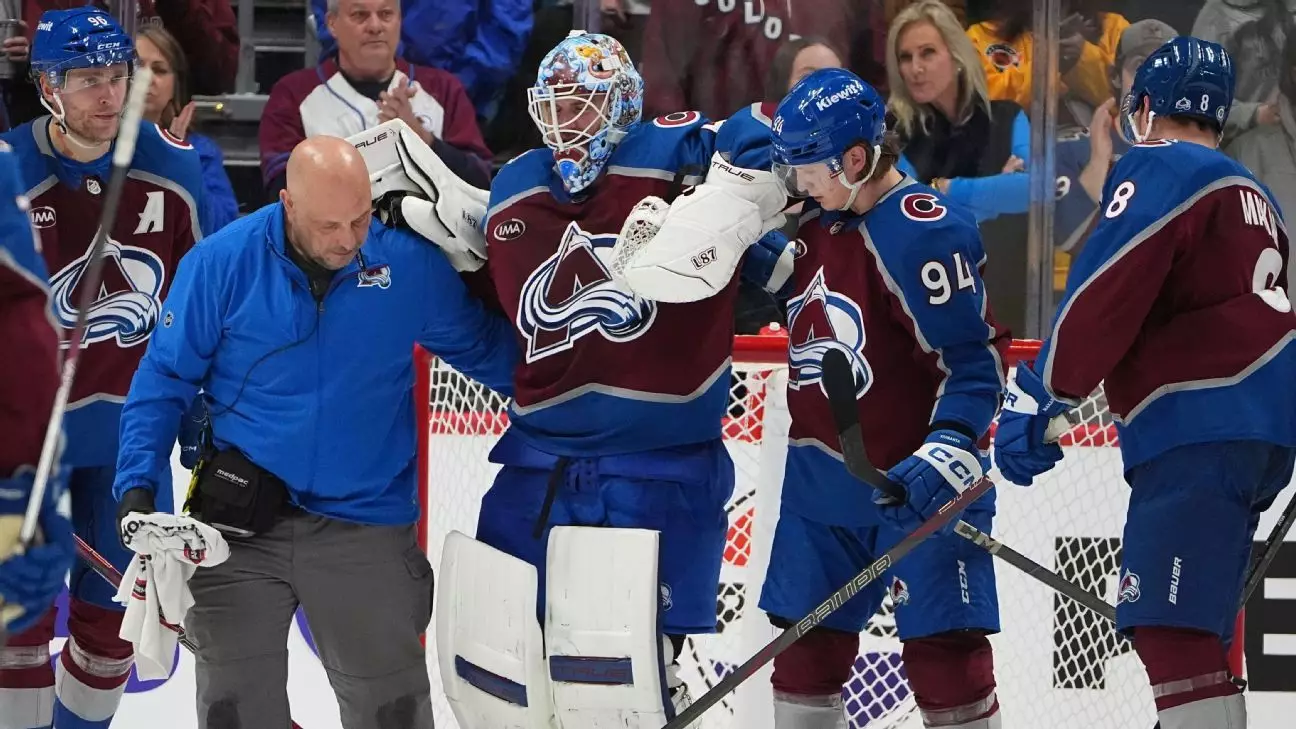In a thrilling display of tenacity, the Colorado Avalanche pulled off a stunning comeback to defeat the Buffalo Sabres 6-5 in overtime, but the aftermath of the game left a bitter taste in the mouth of head coach Jared Bednar. His ire was directed not solely at the Sabres but distinctly at the officiating crew for their decision-making during a crucial moment in the third period. This incident raises questions about player safety and the integrity of officiating in this high-stakes sport.
In the third period, Avalanche goaltender Scott Wedgewood found himself in a precarious situation when he was inadvertently collided with by Sabres forward Zach Benson. The controversy erupted when Benson was pushed by Colorado center Parker Kelly, leading to his fall into Wedgewood. As the play continued and the puck found its way into the net, Wedgewood remained down on the ice, visibly in distress. Bednar was incensed by the officials’ decision not to blow the whistle, emphasizing that the well-being of the players, particularly the goaltender, should take precedence over the flow of the game.
Bednar’s frustration was palpable as he expressed his disbelief at the non-call: “If he’s hurt and he’s not getting up… the whistle should go. It’s just that simple.” His comments reflect a broader concern within the hockey community regarding player safety. In a sport known for its physicality, moments like these highlight the precarious balancing act officials must perform between letting the game flow and ensuring player health.
The intricacies of goaltending interference rules add another layer of complexity to this situation. Bednar confronted the officiating crew, questioning why, given the circumstances, a halt in play was not initiated. The Avalanche coach asserted that player safety should not only be a guideline but a priority: “They do it all the time for regular players, because of player safety.” His insistence that the whistle should have been blown, irrespective of the sequence leading to a potential goal, underscores the ongoing debate over how the rules are interpreted and enforced during games.
Furthermore, Bednar’s decision to challenge the goal for goaltender interference, despite knowing the likelihood of success was slim, speaks to a coach’s instinct to defend his players and advocate for the integrity of the game. His actions served a dual purpose: attempting to reverse an unfavorable call while simultaneously bringing attention to what he perceived as a blatant oversight by the officials.
Despite the tumultuous events surrounding Wedgewood’s injury and the questionable goal, the Avalanche demonstrated remarkable resilience. Their ability to rally from a three-goal deficit to secure victory not only speaks to their skill and determination but also to the atmosphere of camaraderie and motivation forged in adversity. Jonathan Drouin’s late tying goal exemplified this spirit, showing that the players were unified in their fight to win for Wedgewood, even in the face of frustration with the officiating.
Defender Devon Toews’ breakaway goal 48 seconds into overtime sealed the victory, providing a moment of elation amid the chaos. “That fired us up,” he noted, underlining the notion that challenges can sometimes galvanize a team rather than dismantle it. This game will likely be etched into their memories not solely for the win but for how the team responded to what could have derailed their efforts.
As Bednar prepared to address the league post-game, it became evident that the fallout from this incident would not simply dissolve with the victory. His intention to reach out to the NHL suggests a desire for accountability and perhaps a call for reevaluation of existing protocols concerning player safety and officiating standards. The challenge remains for the NHL to maintain the sanctity of the game while prioritizing the health of its players, a balancing act that has proven difficult over the years.
While the Avalanche’s resilience is commendable, the incidents leading to and following the game present critical issues that cannot be overlooked. The conversation regarding officiating and player safety is ongoing, and it is crucial for leagues, teams, and fans to engage in discussions that advocate for improvements. The hope is that through such challenges and discussions, the integrity of the sport can be upheld, ensuring a safe environment for all players involved.


Leave a Reply